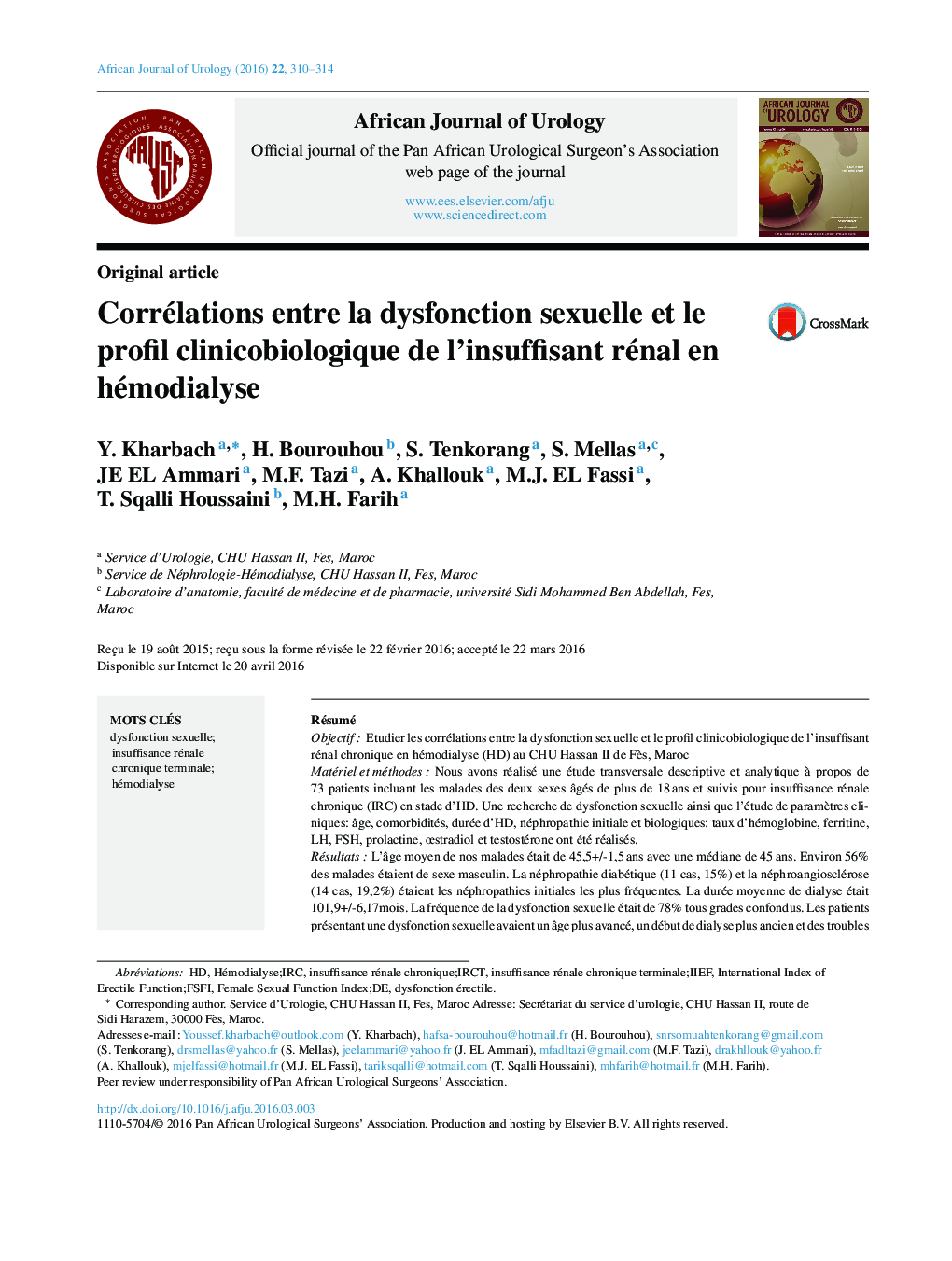| کد مقاله | کد نشریه | سال انتشار | مقاله انگلیسی | نسخه تمام متن |
|---|---|---|---|---|
| 5729558 | 1610694 | 2016 | 5 صفحه PDF | دانلود رایگان |

RésuméObjectifEtudier les corrélations entre la dysfonction sexuelle et le profil clinicobiologique de l'insuffisant rénal chronique en hémodialyse (HD) au CHU Hassan II de Fès, MarocMatériel et méthodesNous avons réalisé une étude transversale descriptive et analytique à propos de 73 patients incluant les malades des deux sexes âgés de plus de 18 ans et suivis pour insuffisance rénale chronique (IRC) en stade d'HD. Une recherche de dysfonction sexuelle ainsi que l'étude de paramètres cliniques: âge, comorbidités, durée d'HD, néphropathie initiale et biologiques: taux d'hémoglobine, ferritine, LH, FSH, prolactine, Åstradiol et testostérone ont été réalisés.RésultatsL'âge moyen de nos malades était de 45,5+/-1,5 ans avec une médiane de 45 ans. Environ 56% des malades étaient de sexe masculin. La néphropathie diabétique (11 cas, 15%) et la néphroangiosclérose (14 cas, 19,2%) étaient les néphropathies initiales les plus fréquentes. La durée moyenne de dialyse était 101,9+/-6,17mois. La fréquence de la dysfonction sexuelle était de 78% tous grades confondus. Les patients présentant une dysfonction sexuelle avaient un âge plus avancé, un début de dialyse plus ancien et des troubles hormonaux significativement plus marqués que les patients sans dysfonction sexuelle. La téstostéronémie était basse chez 32 patients et a été significativement plus bas chez les hommes présentant des troubles sexuels (p = 0,020). Les concentrations de l'estradiol n'étaient pas liées à la dysfonction sexuelle chez les femmes (p = 0,345).ConclusionCertains facteurs cliniques et perturbations biologiques peuvent aider à la compréhension de l'étiopathogénie de ces troubles. Une approche globale peut être proposée basée sur une optimisation des facteurs intervenants. Notre étude souligne l'intérêt d'une surveillance clinique, biologique et hormonale de ces patients.
ObjectiveTo determine the correlation between sexual dysfunction and the clinical and biological profiles of chronic renal failure patients on hemodialysis (HD) at the Hassan II university teaching hospital, Fez, MoroccoPatients and methodsWe conducted a descriptive and analytical crosssectional study that included male and female patients over 18 years of age diagnosed with end stage renal disease requiring hemodialysis. All patients answered a personal questionnaire on their sexuel activity. We studied clinical parameters such as age, comorbidities, hemodialysis duration, initial nephropathy and biological parameters such as hemoglobin, ferritin, LH, FSH, prolactin, estradiol and testosterone.ResultsThe present study was conducted on 73 patients. The mean age of our patients was 45,5+/-1,5. Diabetic nephropathy (11 patients, 15%) and nephrosclerosis (14 patients, 19.2%) were the most frequent initial nephropathies. The mean duration of dialysis was 101.9 + /-6.17 months. The prevalence of sexual dysfunction was 78%. Ageing, years of hemodialysis and hormonal abnormalities correlated significantly with the appearance of sexual dysfunctions. Testosterone level was low in 32 patients and was significantly lower in men with erectile dysfunction (p = 0,020). There was no significant correlation between estradiol levels and sexual dysfunction in women (p = 0,345).ConclusionSome clinical factors and biological disorders may help to understand the pathogenesis of sexual dysfunction. A global approach can be proposed based on the correct management of these intervening factors and the optimization of biological and hormonal surveillance and management of intervening factors.
Journal: African Journal of Urology - Volume 22, Issue 4, December 2016, Pages 310-314